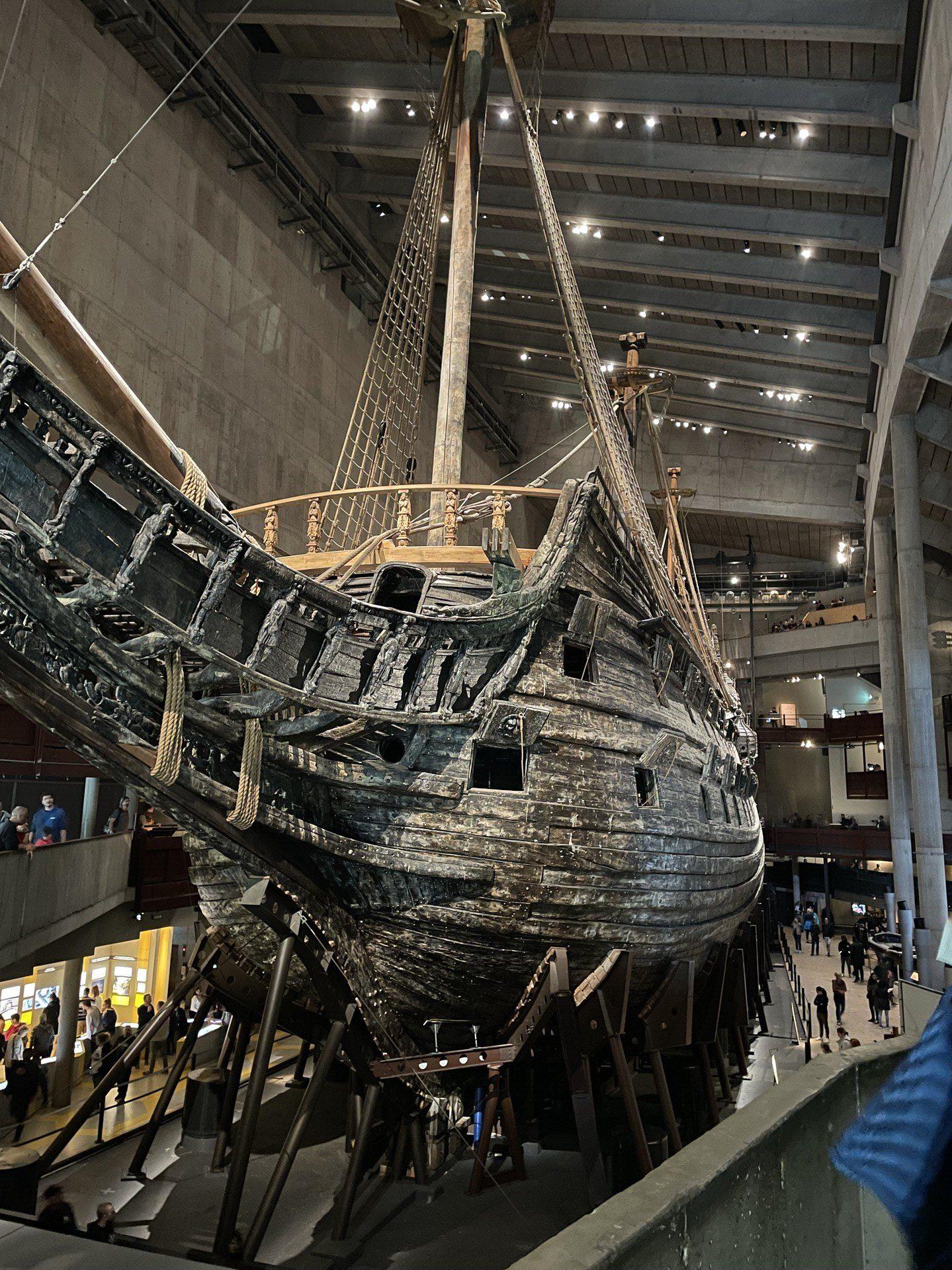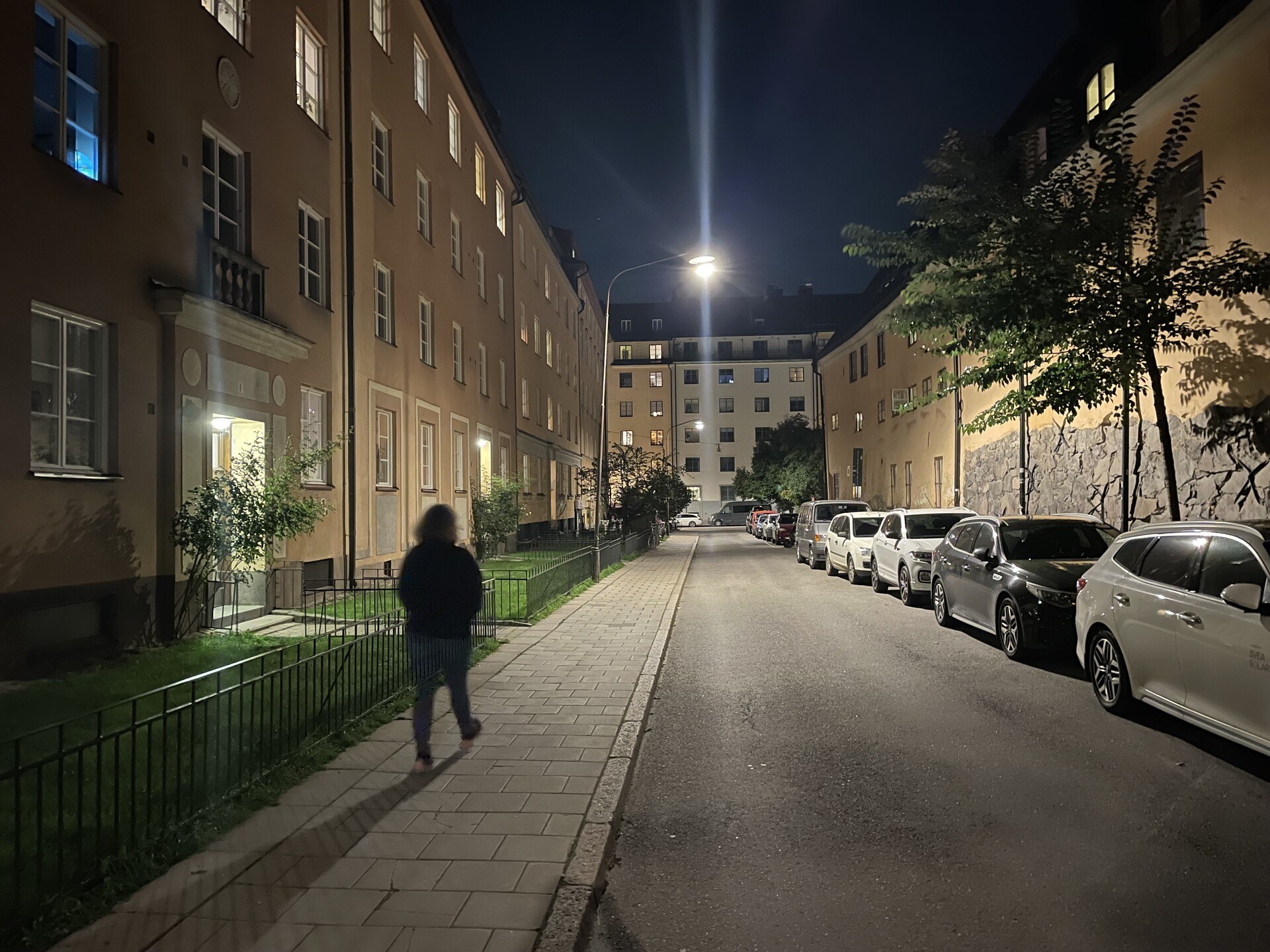Stockholm: Sunday
This is the fourth post in a multi-part series about our trip to Stockholm in fall 2023. All entries here.
Sleep in. It's been a busy couple of days and we deserve it. Besides, the hotel offers breakfast basically unto the afternoon, so we're in no hurry to wander downstairs for a bowl of yogurt and and one of those wheat thins with cream cheese and a little honey. There are a surprising number of late-morning breakfasters with us; I'd been under the impression that the hotel was mostly empty, but suddenly from the woodwork come young folks in their multitudes wearing Luke Combs t-shirts. We gather that there was some sort of show last night that drew the youths from the hinterlands.
We set out eventually on our bikes for the Vasa museum. On the way to the bicycle parking, we pass a great big hole in the road where the utility company is apparently doing some work on pipes laid three or four metres underground. There are no men from the utility company around. The hole is cordoned off by plastic fencing, but it occurs to me that a distracted cyclist could wind up at the bottom of the big hole without too much trouble. As we walk past, Sam and I chant, "Big hole, big hole, big hole," at increasing volumes.
The Vasa is a huge 17th-century Swedish warship, built at great expense to the Swedish crown and meant to signal Sweden's naval superiority in the Baltic, but which was blown over in a stiff wind about a mile into its maiden voyage, where it sank into the salish mud of Stockholm harbour. It was rediscovered in the 1960s and floated back to the surface, then transferred to a purpose-built museum where it's been preserved, almost totally intact, ever since.


The museum itself is a big concrete thing kept at a precise temperature and humidity, and shrouded in wood-preserving darkness. The lobby is perhaps deliberately claustrophobic in contrast to the soaring space that houses the ship itself. Which, if it it isn't obvious to you (as it isn't obvious to me), 17th-century warships are big.
They let you get surprisingly close to the boat. Not touching distance, mind, but close enough to smell the wood, to see the grain, to look through the cannon ports at the shadowy belowdecks. The whole ship has been stripped bare—no paint, no trimmings, no furniture—but it's been partially rigged, which lends a lot to its majesty. It's big in the same way cathedrals are big. It looms, literally and figuratively. The museum spans five or six mezzanines alongside the ship itself, but on all but the top two you're craning your head Copernicanly to the gunwales, the shrouds, the transom. A few hundred people all walking around this way makes for easy collisions between the multicultural crowds—what language do you use to say excuse me?—but we come out unscathed.


Tucked into corners are full-size replicas of different parts of the ship—the middle deck, the crow's nest, the interior of the aftercastle. There's a little diorama of how they raised the ship from the bottom of the harbour. I'm coming to realise that Swedes (and I) love a diorama. There are artifacts that they pulled from the mud. There are wax reconstructions of sailors and real skeletons. There are the remains of rope and yarn. There are sea chests and canteens. It's easy to forget in the majesty of the old boat that its crew were regular folks. Most of the crew escaped when the ship sank, on or above deck—and those people have disappeared into history. Their abandoned belongings, left for hundreds of years in the mud and ogled now by tourists of every stripe, is all that's left of their time here.

The dim atmosphere and the plentiful seating makes the museum a lovely place to spend time, but the humidity control starts to wreak havoc with my sinuses after a little while, and we've made it to the top floor anyway, so we head back down to ground level via a hidden set of stairways and browse the gift shop. Outside, the wind's picked back up and is blowing the leaves about. Our bikes are where we left them.
Seeking novelty, we ride up to Östermalm, in the north east part of the city. We're advised by our guidebook that this is the most expensive part of the city and we want to see what that looks like.
It turns out that it looks like midrise apartments punctuated by hip, expensive cafés and the kinds of stores that sell immaculate navy blue toques and t-shirts for 800 kronor. A couple sitting outside a café look like Patrick Bateman and his girlfriend Reese Witherspoon, except for they're taking turns shooting photos of each other on their new iPhones: with sunglasses on/off, with/without lipstick, legs crossed/uncrossed. Untouched lattes with technically complex foam art sit untouched between them. The café, Bageriet Kringlan, is stylish and historic. Their coffee is good and comes in nice big cups; the kanelbulle is a bit dry and is the traditional spiral shape, rather than the elaborate knot of a truly artisan bulle. It's still better than anything we can get back home, and the currency conversion math is difficult enough that I don't second-guess the cost anyway.
Deciding that Östermalm isn't really for us, we ride back to Södermalm and pop in at the decidedly more accessible shops around our hotel. We duck into a couple of colourful vintage clothing shops, the kind of places that you have to sort of pack yourself down to fit between the aisles of rayon and leatherette and gabardine. Another shopper and I come to an impasse in a doorway and we engage in an elaborate exchange of waves and embarrassed smiles as we try and yield without assuming anything about what languages the other speaks. Later on, in another part of the shop, I overhear her in conversation with a friend: she's British. In the next store we visit, an English bookshop called The English Bookshop, we overhear the clerk recount the days of his youth spent in Minnesota to a couple of American tourists.

We decide to retire to the hotel without purchasing anything, but stop off at the Coop grocery at the end of the street first, for a couple of beers and a spur-of-the-moment pick'n'mix. The beers, by law, are not a hair above 3.5% ABV—only the government-owned alcohol store, the Systembolaget, is allowed to sell stronger stuff—and the pick'n'mix, while at first glance far superior to the UK's home grown Candy King brand in variety and colour, winds up being mostly made up of different styles of hard liquorice covered in ammonium chloride.
For those of you keeping track at home, now-erstwhile Wilko had the greatest pick-n-mix of them all: excellent variety, never stale, binnacles always full to the brim. RIP in peace Wilko.
Back at the hotel w doze off the beer-and-candy comas while more Swiffer ads play on the television in the background. I'm reminded of why we don't have a television at home. There are only so many times you can watch someone shout a highly-European-accented "Wow!" at the tidy path left in the dust piled artificially high on a black coffee table.
We venture back out into the cool dusk for dinner at Meat on a Stick, a celebrated local kebab place. The kebabs here tend to the fancy, loaded with exotic pickles, tahini, harissa, jalapeños. No paying extra for a tub of garlic sauce here. When we're seated, we're handed two Swedish-language menus. I wonder dimly if they only have Swedish menus.
My answer comes before long: a waiter, seeking to rearrange some tables in order to accommodate a crowd of seven or eight university-looking guys 20 minutes before closing time, asks for the table in Swedish (I assume; I don't speak Swedish (yet)). I say, as smoothly as I can manage, "Ja, okej." This both means, and is phonetically indistinguishable from, "yeah, okay." He takes the table; the exchange has either gone so fluently that he didn't notice I'm not Swedish, or so poorly that he couldn't be bothered to correct me. When the waiter's out of earshot, I grin like a goofball at our fortune: either way, we have been mistaken for locals. The waiter returns to provide the university lads, now clustered tightly around two adjoining tables, with a single English menu. "I'm sorry, we only have one English menu." The lads ask for a recommendation from the beer list. The waiter says, "I don't drink, I'm underage."

Satisfied at the end of our meal, we drop a "Tack så mycket!" on the way out the door, and walk back to the hotel. We pass the big hole at the end of the street; it's been filled with rubble while we were out during the day. We chant, "Big hole, big hole, big hole," anyway.

Back at the hotel, the Swiffer ads end and Apollo 13 comes on. I've seen this movie enough times that I can recite large portions of it by heart, but we stay up late watching the whole thing anyway.
Next
Eating our way across Stockholm's neighbourhoods: bullar in Östermalm, fika on Skeppsbro, korvar and meatballs in Södermalm.
Previous
Visiting Birka, drinking a flight of IPAs at a Whippet Bar, attending a post-metal concert, eating grillade korvar.